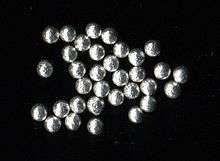Jintan (Japanese medicine)
Jintan (仁丹) is the patented name of a popular Japanese medicine/candy developed by Morishita Hiroshi (1869-1943) and sold from the early twentieth century to today. Originally marketed as a cure-all for a number of ailments, Jintan is today thought of as a breath freshener only.



History
Morishita Hiroshi was the eldest son of a priest at the Nunakuma-Shrine (沼名前神社, Numakuma jinja) in Fukuyama (Hiroshima prefecture). After his father died, Morishita went to Osaka and started to develop pharmaceutical products. He was also a pioneer of Japanese advertising.[1] The silver coated pellet-like pills were advertised from 1904 through the end of World War II. The name Jintan combines the Confucian term jin (仁, humaneness, benevolence) with the Daoist term tan (丹, cinnabar, pills containing cinnabar, pills) evoking the notion of longevity and health.
Composition
Jintan has about 16 ingredients including cinnamon, mint, cumin, clove, and Fructus Amomi.
Packaging
During the Russo-Japanese War the packaging was re-designed as a Meiji period soldier in court dress with bicorne.
Literature
- Sōgō hokenyaku Jintan kara sōgō hoken sangyō JINTAN e - Morishita Jintan 100nen kinenshi. Osaka: Jintan, 1995.
- Machida Shinobu: Jintan ha naze nigai? Meiji-Taishōki no yakuhin kōkoku- zuhanshū. Tokyo, Borantia jōhō-nettowaaku, 1997.
External links
References
- Morishita Jintan 100nen kinenshi